Vision-based Process in Industrial Robots: Revolutionizing Manufacturing
Industrial robots have long been at the forefront of the manufacturing industry, streamlining processes and increasing productivity. With advancements in technology, these robots are now equipped with vision-based systems, allowing them to perform complex tasks with precision and efficiency.
In recent years, vision-based applications in industrial robots have gained significant popularity. These applications utilize cameras and sensors to provide visual feedback to the robots, enabling them to make real-time decisions based on the information received. The result is a more agile and adaptable manufacturing process.
One prime example of vision-based industrial robots is the project undertaken by MAS ROBOTICS. This project showcases the potential of incorporating vision-based systems in various industries such as automotive, electronics, and pharmaceutical. By harnessing the power of artificial intelligence and computer vision, these industrial robots are revolutionizing the manufacturing sector.
The automotive industry, in particular, has greatly benefited from vision-based industrial robots. These robots are capable of performing intricate tasks such as welding, painting, and assembly with high precision. The inclusion of vision-based systems enables them to detect defects, adjust parameters, and make corrections in real-time, ensuring a flawless end product.
Similarly, the electronics industry has witnessed a significant boost in productivity with the integration of vision-based process in industrial robots. These robots can identify and sort components accurately, reducing errors and eliminating the need for manual intervention. Additionally, they can inspect circuit boards for faults, ensuring a higher quality of finished products.
In the pharmaceutical industry, vision-based industrial robots have proven to be a game-changer. These robots can precisely handle delicate substances and perform intricate tasks such as labeling and packaging. The vision-based systems allow them to identify specific shapes and sizes, ensuring accurate packaging and reducing the risk of human errors.
The benefits of vision-based process in industrial robots extend beyond specific industries. By incorporating these systems, manufacturing companies can experience improved efficiency, reduced waste, and increased productivity. These robots can work autonomously, eliminating the need for constant supervision and freeing up human resources for more complex tasks.
The future of vision-based industrial robots looks promising. As technology continues to evolve, these robots will become even smarter and more versatile. They will have the capability to adapt to changing production requirements, identify anomalies, and make decisions in real-time. This will result in a more agile manufacturing sector that can respond quickly to market demands.
The introduction of vision-based process in industrial robots has not been without challenges. Integration and calibration of the vision systems can be complex and time-consuming. Additionally, there is a need for skilled technicians to operate and maintain these sophisticated systems. However, the benefits outweigh the challenges, making it a worthy investment for manufacturing companies.
In conclusion, vision-based process in industrial robots is transforming the manufacturing landscape. The ability of these robots to see, interpret, and respond to visual information makes them invaluable assets in various industries. Projects like MAS ROBOTICS’ vision-based applications serve as exemplars of the potential of this technology. As we look towards the future, it is evident that vision-based industrial robots will continue to play a vital role in revolutionizing manufacturing.
Industrial Robot
“Revolutionizing Manufacturing with Vision-Based Applications: Industrial Robots at Work”


